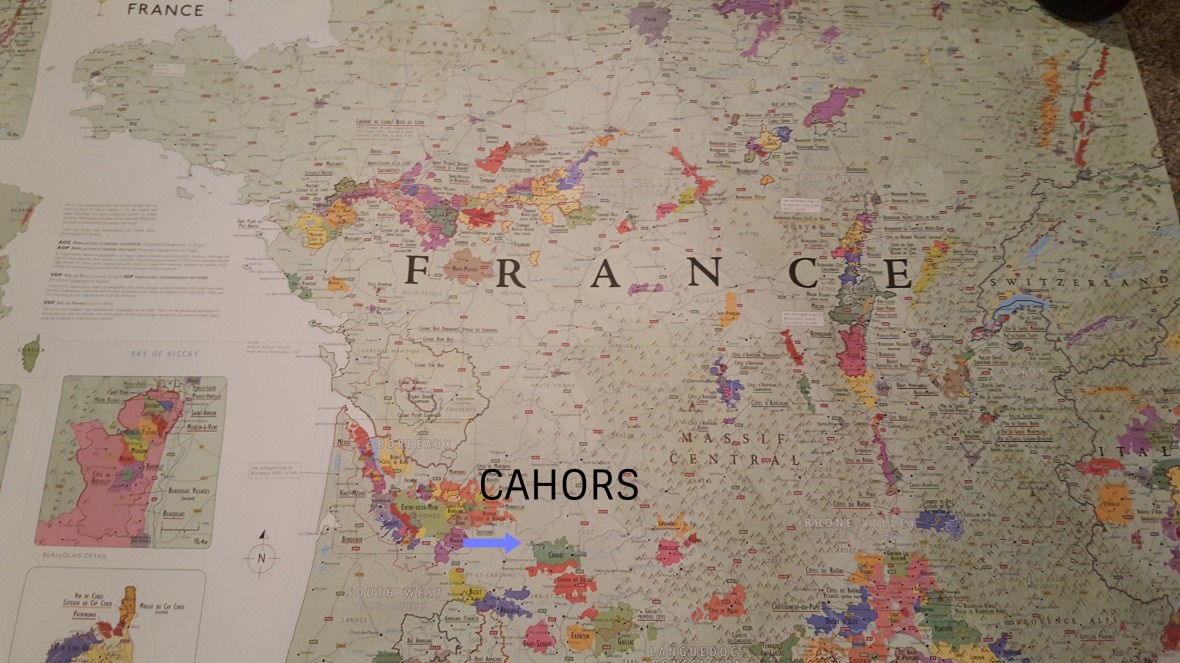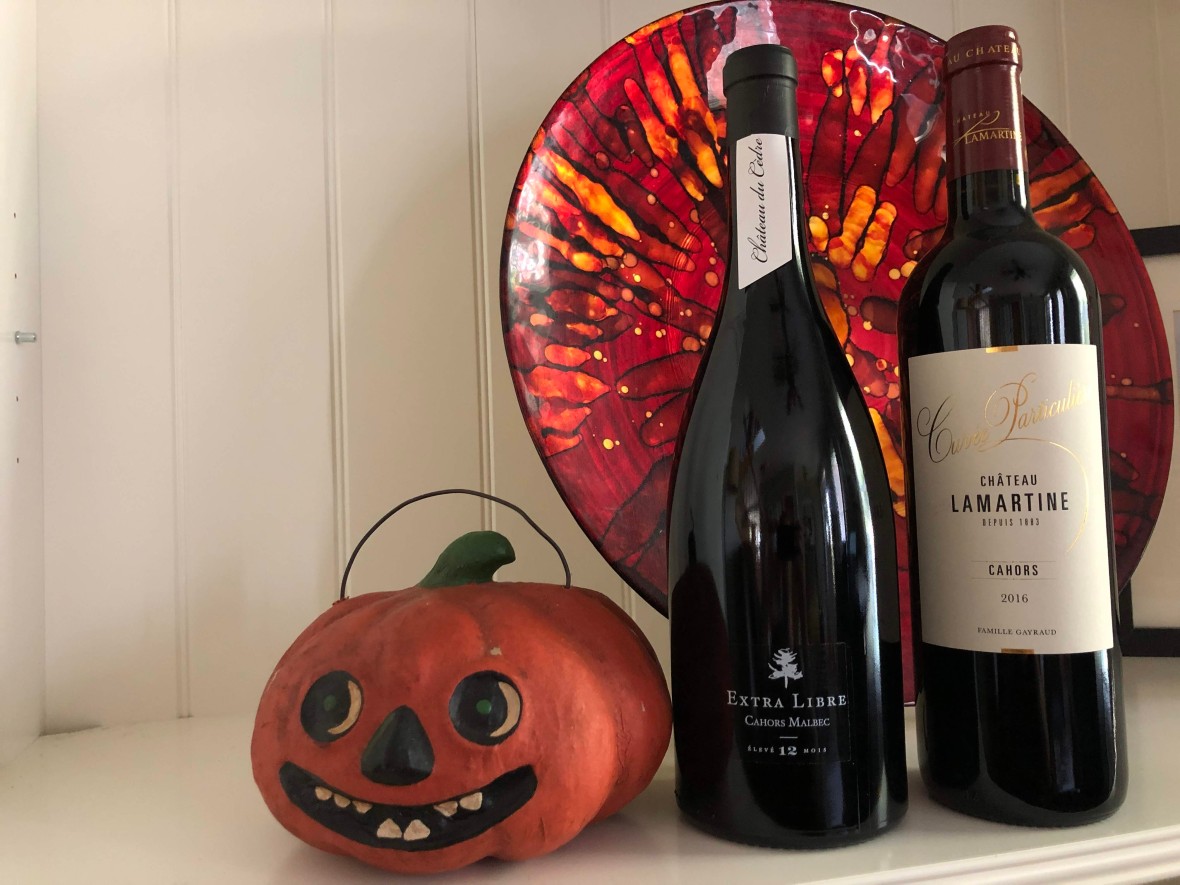
Photo credit: Jill Barth
This month our French #Winophiles take a look at Cahors, a wine I’m calling a true French classic. Why’s that?
This little village is located along the River Lot in southwest France, in the Occitanie department with wines that identify with a Sud-Ouest classification. One of the oldest grape growing regions in France, river access allowed Cahors wines mobility and earned Cahors a place on the tables of royalty.
The wines of this region earned a reputation in the Middle Ages. While it may be hard to picture life as a wine drinker at that time let’s set the scene. Fancy people had a taste for the “black wines” of Cahors and according to Nancy L. Sweet, foundation plant services historian at University of California, Davis:
“Wine from Cahors was reputedly served at the 1152 wedding of Eleanor of Aquitaine and Henry II of England.
In 1225, Henry III of England forbade Bordeaux authorities from stopping or taxing wines sent by Cahors merchants who were under his protection.
Pope John XXII, who was born in Cahors in the 14th century, used vintages from that area as sacramental wines at Avignon.
François I liked the wine from Cahors so much that he installed grapevines from that Quercy district in the vineyard at Fontainebleu in about 1531.
Tsar Peter the Great preferred Cahors wine because he could tolerate it with his ulcerated stomach.”

Photo credit: Jill Barth
The grape, as we know it today, is malbec, but it was called côt or auxxerois (not to be confused with the white variety named auxxerois in Burgundy and Alsace). There were many other naming conventions over the years, from various origins—it wasn’t until the grape was propagated in certain parts of Bordeaux did it get renamed malbec, where it still holds sway as a blending grape.
According to Sweet, “Oral history in Bordeaux holds that a Hungarian viticulturist named Malbeck or Malbek brought the grape to the Médoc/Gironde in the Left Bank region of Bordeaux, where the winemakers blended it into claret for the dark juice quality.”
DNA analysis ties the native location of the variety, whatever the true name may be, to Cahors. The region suffered, from war and frost and phylloxera, and it wasn’t until the 1950’s did momentum rebuild in the growing region. In 1971, it gained AOC status, depending 70% on the malbec-slash-côt as the primary component. Tannat and merlot may be sprinkled in.
In Cahors, the limestone-rich soil and long sunny days brings out the dark-skinned nature of sometimes stern tannins. It’s got an old world flavor that is savory, more meaty and less fruit forward that its new world counterpart, a well-known wine that shares a varietal nature: malbec from Argentina. Argentine growers have embraced malbec in such a way that their treatment could be seen as a full-on revival.

Bottles to try:
Château de Gaudou Le Sang de ma Terre 2018: Fabrice Durou is the 7th generation to tend to the Gaudou vineyards in Cahors, with vines aged an average for 45 years. The property holds HVE status for high environmental value and the vineyard is in conversion to organic AB, Agriculture Biologique.
Château Lamartine Cuvée Particulière Cahors 2016: The Gayraud family have made wine for four generations. The current generation’s great grandfather, Edouard Sérougne, was one of 15 Cahors winemakers that worked to obtain the AOP in 1971. The vines for this release are between 40-60 years old and the bottle could age from another 3-10 years.
Château du Cèdre Cahors Extra Libre 2018: Château du Cèdre Cahors is a family estate run by Pascal and Jean-Marc Verhaeghe who are inspired by the climat system in Burgundy. Extra Libre is sourced from two terroirs, one of stony clay and limestone, another of clay, sand densely populated with pebbles. This bottle is made with no added sulfites.
More on Cahors: Cahors, Your Favorite Wine For Fall
The French Winophiles
This month Nicole of Somm’s Table hosts the French #Winophiles blogging group in an exploration of Cahors (check out her invitation post for a cheat sheet on the region, as well as a geeky deep dive into the terroir).
Join us on Saturday, October 19th at 8:00 am Pacific time / 11:00 am Eastern time on Twitter by following the hashtag #Winophiles. Thanks to Vinconnexion and Vin de Cahors to provide samples for some of the French #Winophiles.
(Note: the wines mentioned in my post are media samples, but no compensation has been provided and all opinions are my own.)
Here’s what’s on:
- Jane from Always Ravenous explores the “Flavors of Fall Paired with Cahors Malbec”
- Cathie of Side Hustle Wino looks at “Cahors – The Birthplace of Malbec“
- Here on L’Occasion we share “Cahors, a French Classic“
- Camilla of Culinary Adventures with Camilla will be posting “Château du Cèdre Extra Libre 2018 Malbec + Cider-Braised Chicken Thighs”
- Wendy Klik of A Day in the Life on the Farm samples “A Trio of Cahors Wine and the Pairings Served”
- Jeff of FoodWineClick! gives us “The Malbec You Never Knew: Cahors“
- Linda of My Full Wine Glass shares “Newbies to Old-World Malbec Discover Cahors“
- Cindy of Grape Experiences explores “The Old-World Style of Malbec from Cahors“
- Deanna of Asian Test Kitchen give us “French Malbecs Meet Chinese Duck 4 Ways“
- Gwen from Wine Predator shares “From Cahors: Biodynamic Chateau du Cedre Malbec with French Charcuterie”
- Pinny of Chinese Food & Wine Pairings matches “Cahors Malbecs and American Wagyu Beef Asian BBQ ”
- Cynthia and Pierre of Traveling Wine Profs give us “Cahors, Hainan Chicken Rice, and the Stories Wine Books Tell“
- Susannah of Avvinare will be “Shedding Light on Old World Malbec from Cahors”
- Payal of Keep the Peas discusses “Cahors: What Put Malbec on the Map”
- Rupal of Syrah Queen will posting “Cahors – Tasting “Black Wines” With The Original Malbec”
- David of Cooking Chat pairs “Mushroom Truffle Risotto with Cahors Malbec”
- And our host Nicole is “Bringing Home Cahors with Clos D’Audhuy” on Somm’s Table.

I love a good Cahors. Visited Château du Cèdre earlier this year. Definitely one of my favourites.
LikeLike
I knew Cahors had a lot of history but some interesting new tidbits here!
LikeLike
What wonderful historical tidbits about Cahors wine! I didn’t realize just how much royalty did drink it. I write about the wines again, so I will reference back to this really great post!
LikeLike
Thanks so much for arranging the samples Jill. I enjoyed learning more about this region of France.
LikeLike
“Stern” is such a good word to describe this old-world wine. That’s a happy-looking pumpkin in the photo, though. Thanks for arranging samples!
LikeLike
Such a fascinating and under-rated region!
LikeLike
I quite agree, Cahors is a true French classic! As always, a very well-written blog post.
LikeLike
I love the historical tidbits you’ve shared! Thanks so much for helping to arrange the samples.
LikeLike
Cahors is a region rich in history. I look forward to tasting more Malbec from this French region. Thank you for arranging the samples!
LikeLike